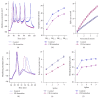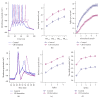Coordinated Plasticity between Barrel Cortical Glutamatergic and GABAergic Neurons during Associative Memory
- PMID: 28070425
- PMCID: PMC5192352
- DOI: 10.1155/2016/5648390
Coordinated Plasticity between Barrel Cortical Glutamatergic and GABAergic Neurons during Associative Memory
Abstract
Neural plasticity is associated with memory formation. The coordinated refinement and interaction between cortical glutamatergic and GABAergic neurons remain elusive in associative memory, which we examine in a mouse model of associative learning. In the mice that show odorant-induced whisker motion after pairing whisker and odor stimulations, the barrel cortical glutamatergic and GABAergic neurons are recruited to encode the newly learnt odor signal alongside the innate whisker signal. These glutamatergic neurons are functionally upregulated, and GABAergic neurons are refined in a homeostatic manner. The mutual innervations between these glutamatergic and GABAergic neurons are upregulated. The analyses by high throughput sequencing show that certain microRNAs related to regulating synapses and neurons are involved in this cross-modal reflex. Thus, the coactivation of the sensory cortices through epigenetic processes recruits their glutamatergic and GABAergic neurons to be the associative memory cells as well as drive their coordinated refinements toward the optimal state for the storage of the associated signals.
Conflict of interest statement
All authors declare that they have no competing interests.
Figures










Similar articles
-
Piriform cortical glutamatergic and GABAergic neurons express coordinated plasticity for whisker-induced odor recall.Oncotarget. 2017 Sep 23;8(56):95719-95740. doi: 10.18632/oncotarget.21207. eCollection 2017 Nov 10. Oncotarget. 2017. PMID: 29221161 Free PMC article.
-
Cell-specific plasticity associated with integrative memory of triple sensory signals in the barrel cortex.Oncotarget. 2018 Jul 24;9(57):30962-30978. doi: 10.18632/oncotarget.25740. eCollection 2018 Jul 24. Oncotarget. 2018. PMID: 30123420 Free PMC article.
-
Barrel Cortical Neuron Integrates Triple Associated Signals for Their Memory Through Receiving Epigenetic-Mediated New Synapse Innervations.Cereb Cortex. 2017 Dec 1;27(12):5858-5871. doi: 10.1093/cercor/bhx292. Cereb Cortex. 2017. PMID: 29121184
-
Functional organization and plasticity in the adult rat barrel cortex: moving out-of-the-box.Curr Opin Neurobiol. 2006 Aug;16(4):445-50. doi: 10.1016/j.conb.2006.06.001. Epub 2006 Jul 5. Curr Opin Neurobiol. 2006. PMID: 16822663 Review.
-
The functional organization of the barrel cortex.Neuron. 2007 Oct 25;56(2):339-55. doi: 10.1016/j.neuron.2007.09.017. Neuron. 2007. PMID: 17964250 Review.
Cited by
-
GABAergic neurons in nucleus accumbens are correlated to resilience and vulnerability to chronic stress for major depression.Oncotarget. 2017 May 30;8(22):35933-35945. doi: 10.18632/oncotarget.16411. Oncotarget. 2017. PMID: 28415589 Free PMC article.
-
Synapse Innervation and Associative Memory Cell Are Recruited for Integrative Storage of Whisker and Odor Signals in the Barrel Cortex through miRNA-Mediated Processes.Front Cell Neurosci. 2017 Oct 25;11:316. doi: 10.3389/fncel.2017.00316. eCollection 2017. Front Cell Neurosci. 2017. PMID: 29118695 Free PMC article.
-
Activity-induced spontaneous spikes in GABAergic neurons suppress seizure discharges: an implication of computational modeling.Oncotarget. 2017 May 16;8(20):32384-32397. doi: 10.18632/oncotarget.15660. Oncotarget. 2017. PMID: 28427143 Free PMC article.
-
The interconnection and function of associative memory neurons are upregulated for memory strengthening.Front Neural Circuits. 2023 Jun 15;17:1189907. doi: 10.3389/fncir.2023.1189907. eCollection 2023. Front Neural Circuits. 2023. PMID: 37396398 Free PMC article.
-
Piriform cortical glutamatergic and GABAergic neurons express coordinated plasticity for whisker-induced odor recall.Oncotarget. 2017 Sep 23;8(56):95719-95740. doi: 10.18632/oncotarget.21207. eCollection 2017 Nov 10. Oncotarget. 2017. PMID: 29221161 Free PMC article.
References
-
- Byrne J. H. Cellular analysis of associative learning. Physiological Reviews. 1987;67(2):329–439. - PubMed
Publication types
MeSH terms
Substances
LinkOut - more resources
Full Text Sources
Other Literature Sources

